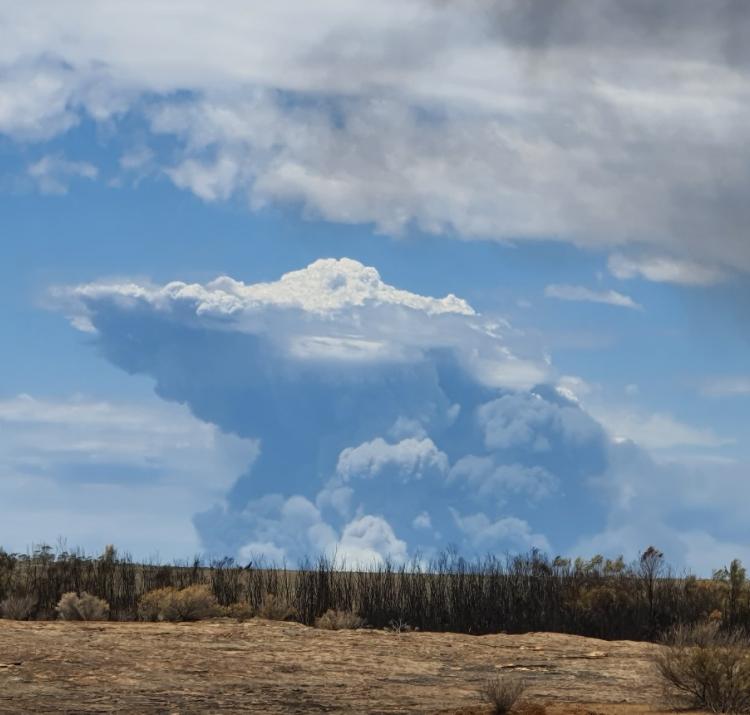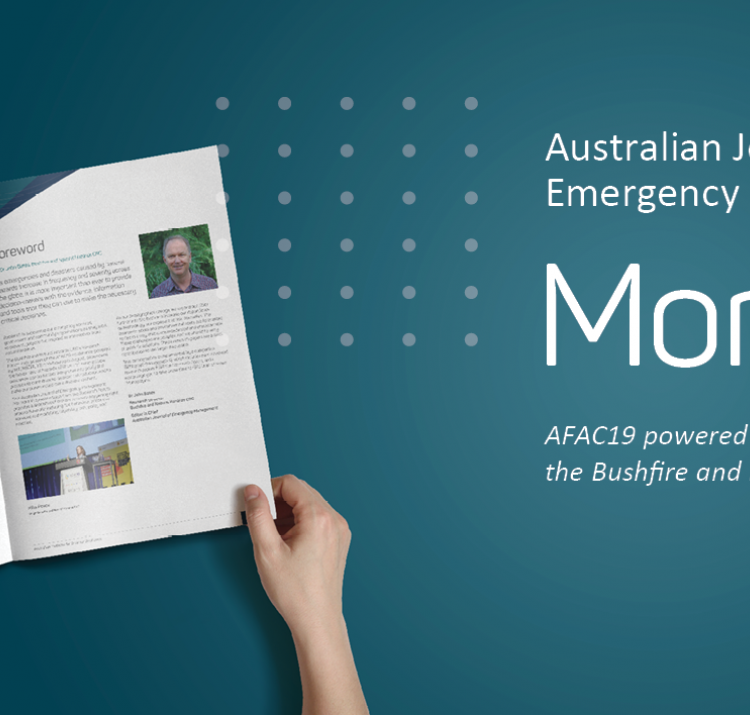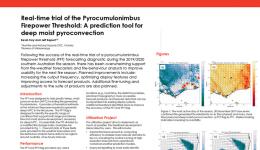Research leader
Research team
End User representatives
This project used high-resolution modelling, together with a range of meteorological data, to better understand and predict important meteorological natural hazards, including fire weather, tropical cyclones, severe thunderstorms and heavy rainfall. The outcomes from the project are contributing to reducing the impact and cost of these hazards on people, infrastructure, the economy and the environment.
Specific case studies undertaken included the New South Wales Blue Mountains bushfires of 2013; ember transport by fire plumes; pyrocumulus cloud simulation and prediction, and the NSW April 2015 East Coast Low.
Ember transport
The study developed an understanding of how fire embers generated during bushfires can be lifted into the atmosphere and carried by winds ahead of a fire front, potentially starting new fires downwind. The team undertook simulations for ember transport for a wide range of wind speeds and ember fall speeds. It is important to consider a range of fall speeds, since different types of embers have different densities and aerodynamic properties which affect how far they are carried.
Pyrocumulonimbus
Plume modelling has also been utilised to study pyrocumulonimbus clouds (PyroCb). Intense fire plumes in suitably moist environments can lead to PyroCb development, with the possibility of strong downbursts which can exacerbate already extreme fire conditions. A survey of current understanding and forecast techniques was completed, and the team has worked towards developing improved techniques.
Blue Mountains bushfire
A detailed case study of the Blue Mountains fires of October 2013 was undertaken, focusing on 17 October when some 200 houses were destroyed. Analysis uncovered a weather phenomenon known as mountain waves which contributed to the severe fire behaviour. Mountain waves are atmospheric oscillations that occur due to air flowing over hills or mountains. They can arise in several different ways, some more predictable than others. Often they cause strong downslope winds on the lee slope of the hill or mountain.
April 2015 East Coast Low
Collectively, the ensemble weather simulations accurately predicted the position and intensity of the low, the strong winds and the rainfall. The differences between them give insight as to the forecast uncertainty, the overall envelope of areas at some risk, and the areas at highest risk. The ensemble also enables insight into the processes that lead to the rapid intensification of these systems. The team is continuing to learn from ensemble simulations about predictability of East Coast Lows and how to use this information to benefit both forecasters and the emergency services.
Specific outcomes of this project have:
- improved the scientific understanding of severe weather phenomena in Australia
- improved the knowledge of how to best predict these phenomena, including model configuration and interpretation
- contributed to the post-event analysis and lessons learned of selected severe events that occur during the course of the project
- informed the development of numerical weather prediction systems specifically for severe weather.
| Year | Type | Citation |
|---|---|---|
| 2022 | Report | Improved predictions of severe weather to reduce community impact – final project report. (Bushfire and Natural Hazards CRC, 2022). |
| 2020 | Journal Article | Pyrocumulonimbus Firepower Threshold: Assessing the atmospheric potential for pyroCb. Weather and Forecasting (2020). doi:https://doi.org/10.1175/WAF-D-20-0027.1 |
| 2020 | Report | The real-time trial of the Pyrocumulonimbus Firepower Threshold. (Bushfire and Natural Hazards CRC, 2020). |
| 2020 | Report | Improved predictions of severe weather to reduce community impact. (Bushfire and Natural Hazards CRC, 2020). |
| 2019 | Conference Paper | A case study of South Australia's severe thunderstorm and tornado outbreak . AFAC19 powered by INTERSCHUTZ - Bushfire and Natural Hazards CRC Research Forum (Australian Institute for Disaster Resilience, 2019). at <https://knowledge.aidr.org.au/resources/australian-journal-of-emergency-management-monograph-series/> |
| 2019 | Conference Paper | Pyrocumulonimbus Firepower Threshold: a pyrocumulonimbus prediction tool. AFAC19 powered by INTERSCHUTZ - Bushfire and Natural Hazards CRC Research Forum (Australian Institute for Disaster Resilience, 2019). at <https://knowledge.aidr.org.au/resources/australian-journal-of-emergency-management-monograph-series/> |
| 2018 | Journal Article | Wave ensemble forecasts for tropical cyclones in the Australian region. Ocean Dynamics 68, 603-625 (2018). |
| 2018 | Journal Article | The boundary layer dynamics of tropical cyclone rainbands. Journal of the Atmospheric Sciences 75, (2018). |
| 2018 | Report | Models of buoyant plume rise. (Bushfire and Natural Hazards CRC, 2018). |
| 2017 | Conference Paper | Secondary eyewall formation in tropical cyclones. AFAC17 (Bushfire and Natural Hazards CRC, 2017). |
| 2017 | Conference Paper | Research proceedings from the 2017 Bushfire and Natural Hazards CRC and AFAC Conference. Bushfire and Natural Hazards CRC & AFAC annual conference 2017 (Bushfire and Natural Hazards CRC, 2017). |
| 2017 | Conference Paper | Thermodynamic considerations of pyrocumulus formation. AFAC17 (Bushfire and Natural Hazards CRC, 2017). |
| 2017 | Journal Article | Time and space scales in the tropical cyclone boundary layer, and the location of the eyewall updraft. Journal of the Atmospheric Sciences (2017). doi:10.1175/JAS-D-17-0077.1 |
| 2017 | Journal Article | The contribution of turbulent plume dynamics to long-range spotting. International Journal of Wildland Fire 26, 317-330 (2017). |
| 2017 | Report | Improved predictions of severe weather to reduce community impact: midterm report 2014-17. (Bushfire and Natural Hazards CRC, 2017). |
| 2016 | Conference Paper | The effects of turbulent plume dynamics on long-range spotting. AFAC16 (Bushfire and Natural Hazards CRC, 2016). |
| 2016 | Conference Paper | Long-range spotting by bushfire plumes: The effects of plume dynamics and turbulence on firebrand trajectory. 5th International Fire Behaviour and Fuels Conference (International Association of Wildland Fire, 2016). |
| 2016 | Conference Paper | Large-eddy simulations of pyro-convection and its sensitivity to mositure. 5th International Fire Behaviour and Fuels Conference (International Association of Wildland Fire, 2016). |
| 2016 | Conference Paper | Research proceedings from the 2016 Bushfire and Natural Hazards CRC and AFAC conference. Bushfire and Natural Hazards CRC & AFAC annual conference 2016 (Bushfire and Natural Hazards CRC, 2016). |
| 2016 | Conference Paper | Mesoscale features related to the Blue Mountains fires of 17 October 2013 revealed by high resolution Numerical Weather Prediction (NWP) modelling. 5th International Fire Behaviour and Fuels Conference (International Association of Wildland Fire, 2016). |
| 2016 | Report | Pyrocumulonimbus forecasting: needs and issues. (Bushfire and Natural Hazards CRC, 2016). |
| 2016 | Report | Improved predictions of severe weather to reduce community impact: Annual project report 2015-2016. (Bushfire and Natural Hazards CRC, 2016). |
| 2015 | Conference Paper | Managing Severe Weather - Progress and Opportunities Conference Paper 2014. Bushfire and Natural Hazards CRC and AFAC Wellington Conference 2014 (2015). |
| 2015 | Conference Paper | Modelling the Fire Weather of the Coonabarabran Fire of 13 January 2013. Bushfire and Natural Hazards CRC and AFAC Wellington Conference 2014 (2015). |
| 2015 | Conference Paper | Research proceedings from the 2015 Bushfire and Natural Hazards CRC & AFAC conference. Bushfire and Natural Hazards CRC & AFAC annual conference 2015 (Bushfire and Natural Hazards CRC, 2015). |
| 2015 | Conference Paper | Large-eddy simulations of pyro-convection and its sensitivity to environmental conditions - peer viewed. Adelaide Conference 2015 (2015). |
| 2015 | Journal Article | Simulating boundary-layer rolls with a numerical weather prediction model. Quarterly Journal of the Royal Meteorological Society 1-14 (2015). at <http://www.cawcr.gov.au/staff/jdk/Kepert_papers/Thurston_etal_2015_qjrms_acc.pdf> |
| 2015 | Presentation | Improved predictions of severe weather to reduce community risk. (2015). |
| 2015 | Report | Pyrocumulonimbus: A Literature Review. (2015). |
| 2015 | Report | Improved predictions of severe weather to reduce community impact: Annual project report 2014-2015. (Bushfire and Natural Hazards CRC, 2015). |













































